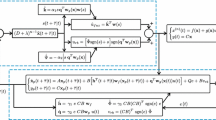Abstract
Delay time, which may degrade the control performance, is frequently encountered in various control processes. The fuzzy neural network sliding mode controller (FNNSMC), which incorporates the fuzzy neural network (FNN) with the sliding mode controller (SMC), is developed to control the long delay system with unknown model based on fuzzy prediction algorithm in the paper. According to the characteristics of the long delay systems, we simulate the manual operating process and predict the delayed error and its derivative based on the information of the input and output variables of the process, and then feedback these prediction values to the FNN and train the FNN with the regulation function by the idea of sliding mode control until the better control results are obtained. The FNNSMC has more robustness due to the abilities of the learning and reasoning and can eliminate the drawbacks of the general SMC, namely the chattering in the control signal and the needing knowledge of the bounds of the disturbances and uncertainties. Simulation examples demonstrate the advantages of the proposed control scheme.











Similar content being viewed by others
References
Richard JP (2003) Time-delay systems: an overview of some recent advances and open problems. Automatica 39:1667–1694
Ziegler JG, Nichols NB (1942) Optimum setting for automatic control. Trans ASME 64:759–768
Smith OJM (1957) Closer control of loops with deadtime. Chem Eng Prog 53:217–225
Huang JJ, DeBra DB (2002) Automatic smith-predictor tuning using optimal parameter mismatch. IEEE Trans Control Syst Technol 10:447–459
Li JC, Jron JC (1992) A new learning controller based on the P-integrator concept. Fuzzy Sets Syst 48:297–303
Hagglund T (1992) A predictive PI controller for process with long dead time. IEEE Control Syst Mag 12:57–60
Kristiansson B, Lennartson B (2001) Robust PI and PID controllers including Smith predictor structure. In: Proceedings of the American control conference, Arlington, 2197–2202
Utkin V, Guldner J, Shi J (1999) Sliding modes in electromechanical systems. Taylor & Francis, London
Li XQ, Yurkovich S (2001) Sliding mode control for delayed systems with application to engine idle speed control. IEEE Trans Contr Syst Tech 9:802–810
Niu Y, Lam J, Wang X, Ho D (2003) Sliding-mode control for nonlinear state-delayed systems using neural-network approximation. IEE Proc Contr Theory Appl 150:233–239
Basin M, Rodriguez J, Acosta P, Fridman L (2003) Robust integral sliding mode regulator for linear systems with multiple time delay in control input. IEEE 42nd international conference on decision and contribution, pp 4056–4061
Aoki S, Kuwachi S, Sugeno M (1990) Application of fuzzy control logic for dead-time process in a glass melting furnace. Fuzzy Sets Syst 38:251–265
Balestrino A, Veron FB, Landi A (1998) On-line process estimation by ANNS and smith controller design. IEE Proc Control Theor Apllicat 145:231–235
Huang JQ, Lewis FL (2003) Neural-network predictive control for nonlinear dynamic system with time-delay. IEEE Trans Neural Netw 14:377–389
Chen SB, Wu L, Wang QL (1997) Self-learning fuzzy neural networks for control of uncertain systems with time delay. IEEE Trans Syst Man Cybern B 27:142–148
Cao YY, Frank PM (2000) Analysis and synthesis of nonlinear time-delay systems via fuzzy control approach. IEEE Trans Fuzzy Syst 8:200–211
Chen TC, Shen TT (2001) Model reference robust speed control for induction-motor drive with delay based on neural network. IEEE Trans Syst Man Cybern B 31:746–753
Ge SS, Hong F, Lee TH (2004) Adaptive neural control of nonlinear time-delay systems with unknown virtual control coefficients. IEEE Trans Syst Man Cybern B 34:499–516
Da FP, Xu SX, Song WZ (1999) Intelligent control of basis weight and moisture content in paper-making process. Control Theory Applicat 16: 458–460
Da FP (2006) Sliding mode predictive control for long delay time systems. Phys Lett A 348:228–232
Nguyen HT, Walker EA (2000) A first course in fuzzy logic, 2nd edn. Chapman & Hall/CRC, London/West Palm Beach
Lin CT, Lee CSG (1995) Neural fuzzy systems: a neuro-fuzzy synergism to intelligent systems. Prentice-Hall, Englewood Cliffs
Da FP (2000) Decentralized sliding mode adaptive controller design based on fuzzy neural networks for interconnected uncertain nonlinear systems. IEEE Trans Neural Netw 11:1471–1480
Kaynak O, Erbatur K, Ertugrul M (2001) The fusion of computationally intelligent methodologies and sliding-mode control—a survey. IEEE Trans Ind Electron 48:4–17
Efe MO, Kaynak O, Wilamowski BM (2000) Stable training of computationally intelligent systems by using variable structure systems technique. IEEE Trans Ind Electron 47:487–496
Ertugrul M, Kaynak O (2000) Neuro sliding mode control of robotic manipulators. Mechatron 10:9–20
Jezernik K, Rodic M, Safaric R, Curk B (1997) Neural networks sliding mode robot control. Robotica 15:23–30
Ramirez HS, Morles EC (1995) A sliding mode strategy for adaptive learning in adalines. IEEE Trans Circuits Syst I 42:1001–1012
Efe MO, Unsal C, Kaynak O, Yu X (2004) Variable structure control of a class of uncertain systems. Automatica 40:59–64
Lin FJ, Wai RJ (2001) Hybrid control using recurrent fuzzy neural network for linear-induction motor servo drive. IEEE Trans Fuzzy Syst 9: 102–115
Parma GG, Menezes BR, Braga AP (1998) Sliding mode algorithm for training multilayer artificial neural networks. Electron Lett 34:97–98
Yu X, Man Z, Rahman SMM (1998) Adaptive sliding mode approach for learning in a feedforward neural networks. Neural Comput Applicat 7:289–294
Sundareshan MK, Askew C (1997) Neural network-assisted variable structure control scheme for control of a flexible manipulator arm. Automatica 33:1699–1710
Khalil HK (2002) Nonlinear system, 3rd edn. Prentice-Hall, Englewood Cliffs
Author information
Authors and Affiliations
Corresponding author
Additional information
This work was supported by 973 program of China (No. 2002CB312200) and BK2003405.
Rights and permissions
About this article
Cite this article
Da, F. Fuzzy neural network sliding mode control for long delay time systems based on fuzzy prediction. Neural Comput & Applic 17, 531–539 (2008). https://doi.org/10.1007/s00521-007-0130-x
Received:
Accepted:
Published:
Issue Date:
DOI: https://doi.org/10.1007/s00521-007-0130-x




